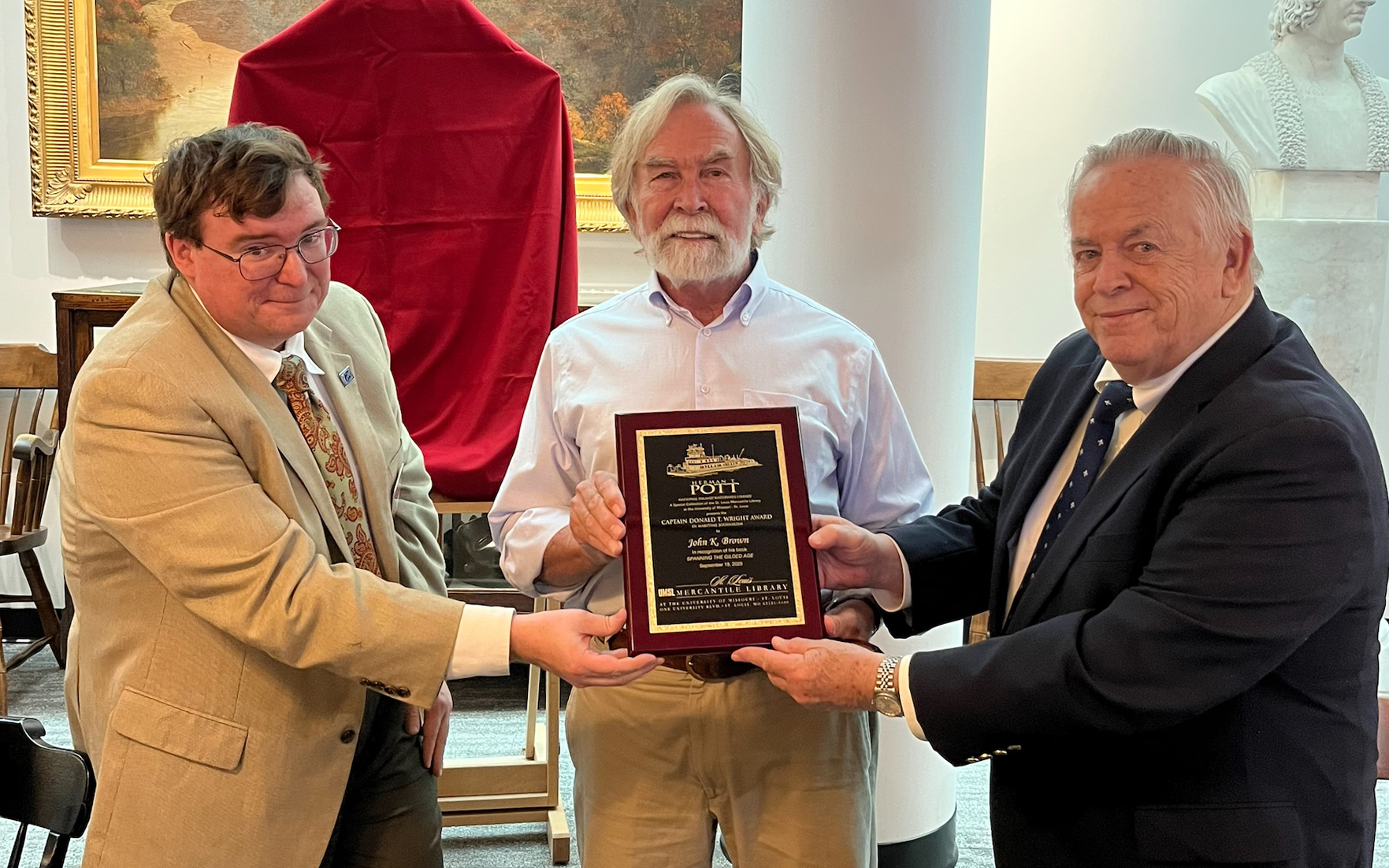The Herman T. Pott National Inland Waterways Library, a special collection of the St. Louis Mercantile Library, recently recognized John K. Brown for his book “Spanning the Gilded Age.” Nicholas Fry, curator of the library, and Tom Dunn, the library’s chairman, presented Brown with the Donald T. Wright Award at a ceremony on September 19. The award is presented annually to an individual whose work “has contributed to a better understanding of the American inland waterways.”
Brown, the author of “The Baldwin Locomotive Works, 1831–1915: A Study in American Industrial Practice,” taught history, applied ethics and writing in the University of Virginia Department of Science, Technology and Society. In “Spanning the Gilded Age,” he eloquently describes the construction the Eads Bridge, which spans the Mississippi River between St. Louis and East St. Louis, Ill. In the book, Brown “details the origins, design, construction and enduring impact of a unique feat of engineering, and (he) illustrates how Americans built their urban infrastructure” during the 1800s.”
The book offers fresh perspectives on James Eads and his bridge. As the project began in 1867, Eads was a late-arriving gate crasher competing against four other ventures, which were led by men with considerable experience in civil engineering. By contrast, Eads had left formal schooling after the eighth grade.
His ties to New York financiers proved crucial. The money men mattered because a profit-seeking corporation would build any bridge, not government. After visiting France, Eads introduced the use of pneumatic caissons to North America in order to take his stone bridge piers down 100 feet to bedrock beneath the flowing river. To prepare for his great work constructing the Brooklyn Bridge, Washington Roebling came to St. Louis, descended to the caisson and studied every detail of the Eads Bridge.
In another bold leap, Eads specified steel chords for his record-breaking shallow arches—the first application of structural steel anywhere in the world.
“By detailing influential figures such as James Eads, the Morgans, Andrew Carnegie, and Jay Gould, ‘Spanning the Gilded Age’ offers new perspectives on an era that saw profound changes in business, engineering, governance and society,” the book’s synopsis states. “Beyond the bridge itself, Brown explores a broader story: how America became urban, industrial and interconnected. This triumph of engineering reflects the Gilded Age’s grand ambitions, and the bridge remains a vital transportation artery today.”
John Barry, author of “Rising Tide: The Great Mississippi Flood of 1927 and How it Changed America,” wrote in his review of Brown’s book, “James Buchanan Eads mastered the Mississippi River, secured the future of St. Louis, forced a revolution in steelmaking and made the port complex around New Orleans the biggest by tonnage in the world. In short, he was one of the most brilliant and important—and forgotten—men of the 19th century. John K. Brown finally does him justice in ‘Spanning the Gilded Age.”
Another review, this one by Thoman J. Misa, author of “Leonardo to the Internet,” states: “Brown serves up a rich slab of American history, from sweaty workers digging to bedrock below the Mississippi River to the rarified heights of transatlantic finance. Fabulous insights on city growth, bold engineering, railroad tangles and classic ‘robber barons’ like Andrew Carnegie and Jay Gould.”
Robert Kanigel, author of “The One Best Way: Frederick Winslow Taylor and the Enigma of Efficiency,” wrote, “Skullduggery, robber baron intrigue and engineering genius on the shores of the Mississippi River after the Civil War: John Brown tells the gripping, many-sided genesis story of Eads’ graceful, steel-arched bridge at St. Louis, set in an era when steel was still an experimental material, and no one knew quite what to do with it.”
Derived from extensive archival research, presented in crisp prose and complemented by 85 illustrations, the 392-page book is available from local booksellers and online. For more information, visit www.greatsteelbridge.com.



